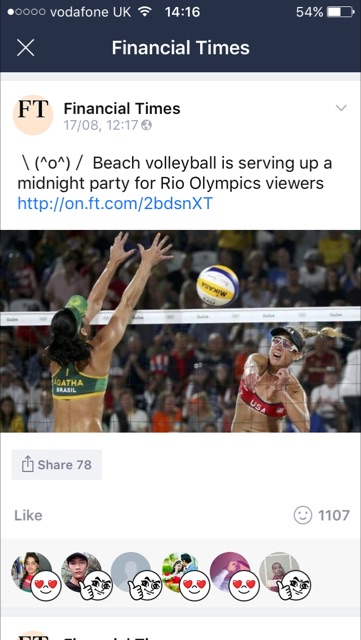Save 50% on a 3-month Digiday+ membership. Ends Dec 5.
Line is the latest app in the Financial Times’ arsenal to reach global audiences

The Financial Times has added Japanese messaging app Line to the number of platforms that it distributes to.
For the past few weeks, the salmon-colored broadsheet has been publishing about four English-language stories per day on Line, along with a long article from its Arts and Culture section. Line’s users are concentrated in Japan, Indonesia, Thailand and Taiwan, so the FT is including stories about Asia in its roundup.
Previous reports estimate that two-thirds of the FT’s readers are outside the U.K. Line represents a way to grow its global audience, said Renée Kaplan, head of audience engagement at the FT. “With WhatsApp, we saw high engagement from audiences in the U.K. and the U.S. but also in India and Singapore.”
So far, the FT has 119,000 followers on Line, which is similar to the engagement other publishers are seeing on the app. Time magazine gathered 125,000 followers in a week. Business Insider launched on the platform last week and has gained 135,000 followers.
These are small numbers in the scheme of things. But the FT, with 780,000 print and digital subscribers, has never been about scale. Line has more features than messaging apps like WhatsApp. On Line, users can order taxis and pay bills, for instance. Other publishers are using Line to experiment with bots before taking a more finished product to Facebook Messenger, where their experiments face a bigger audience. (Line has 218 million users compared to Messenger’s 1 billion.)
“We want to understand what kind of relationship we can create with an audience on this platform,” said Kaplan. “We’ll experiment with a diversity of topics, formats and alerts to understand what the usage is, how this audience on this platform prefers to engage with our journalism, what gives them the most value. If we find that certain formats or the alert experience gets high engagement, we’ll adjust.”

The FT’s stories that have had the highest engagement so far on Line were those on the Rio Olympics, like this one on how cycling teams try to shave milliseconds off their times, which had 1,100 likes and 58 shares, and this one on the midnight volleyball parties, which had 1,100 likes and 78 shares. These pieces also let the FT show prospective readers that it covers more than just global politics and finance, which it’s best known for.
Beyond Line, the FT has been experimenting with other ways of getting new audiences to try it out. Last year, it introduced paid monthly trials, letting users access a month’s worth of articles for £1 ($1.42). At the same time, it made more content available on social media outside its strict paywall. In May, it started posting one of these freely accessible stories to WhatsApp, using a mix of emojis too, and managed by the social media team of five journalists. Some of these will be made available on Line too, like this piece on how London could reinvent itself after Brexit.
For the FT, Line is part of its broader strategy to understand the relationship between platforms and subscribers. “It’s about getting insights on how best to serve an increasingly mobile and global audience,” said Kaplan, “insights on a young, Asian audience that might also help inform our curation and engagement strategies on other platforms.”
Images via the Financial Times.
More in Media

How AI’s hit to publisher traffic is quietly rewiring media M&A
Publishers’ AI-driven traffic declines are cooling M&A, stalling deals and lowering valuations. Some analysts are optimistic about 2026.

Digiday+ Research: Where publisher revenue stands with ads, video, content licensing and subscriptions
Digiday+ Research conducted a survey among nearly 40 publisher professionals in Q3. Here is what they had to say about their different revenue sources.

AI-powered professional learning: Inside the launch of Deloitte’s Scout
Deloitte last month launched Scout as part of its Project 120, the company’s $1.4 billion investment in professional development.





